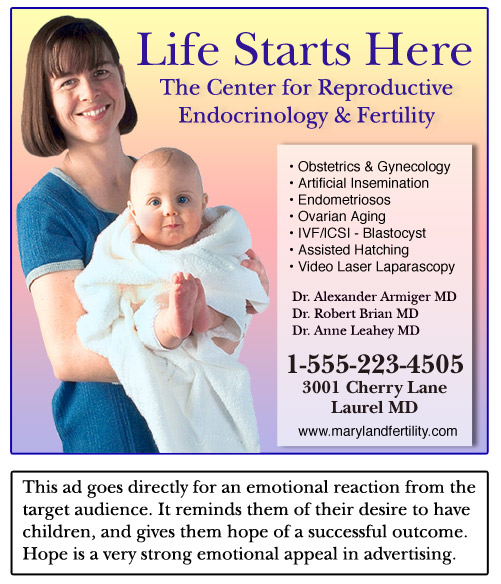
Introduction
The message contained in the above advertisement by Maryland Medical Center targets a very common, worrisome, frustrating, and in some cases even desperate, medical problem that faces an increasing number of women in the United States as well as other parts of the world today – infertility. In nearly all cases, the victims of this problem are married women. Taking quiet pride in its fame as a reputed Center for Reproductive Endocrinology and Fertility, the advertiser targets its audience by putting forward its claims of remedying their reproductive problems no matter in which category those problems lie.
In what is a subtle display of its vast experience and expertise, the advertisement lists the three categories under which infertility problems are contained. The first is the natural category – Obstetrics and Gynecology, Ovarian Aging and IVF/ICSI Blastocyst – wherein the natural reproductive process in the female body is subtly regulated by the Center’s specialists. The second is the unnatural category – Assisted Hatching and Video Laser Laparascopy – wherein problematic foreign growths outside the uterus are eliminated by the Center’s expert surgeons. The third is the ultimate category – Artificial Insemination – where the target’s problems, unsolvable under the first two categories as well as by the natural process , are solved by implanting male sperm into the female uterus by artificial means.
Body
The advertisement’s attempt to persuade is founded primarily on the human expectation called ‘hope.’ Hope is an emotional reaction of human beings during various stages in their lives when faced with seemingly unconquerable barriers, so much so that there is nobody who can claim that he or she never came across a situation in his or her life where they did not take refuge in hope, for example, to recover from a dangerous illness, escape from a disaster, succeed in an examination, or as in the present case, to give birth to a child.
The advertisement fuels the hope in the target audience who are desperately trying to have a child when all natural remedies have failed assuring them, that there is a satisfactory solution for their problem. In addition, by listing the three categories that commonly contain the solution of all kinds of infertility problems, the advertisement encourages the target audience to come forward for treatment by showing their individual problem is not unique but a common problem that affects many other people like them.
Conclusion
The advertisement’s attempt to persuade is backed secondarily by its shrewd choice of mode of publicity – the daily newspaper and/or the Sunday newspaper. This choice ensures that the advertisement message will reach a wide audience. It is estimated that 57% of adults in the United States read a daily newspaper, spending nearly 45 minutes to do this each day. The number jumps to 67% on a Sunday, when nearly 60 minutes are spent in reading activity that day.
In addition to its initial reading, the advertisement message also benefits from the after affect – the very likely chance of initial readers referring to it again later during the week or month, or recommending it to friends and family members who may not have read it. Considering that there are as many as 1,600 daily newspapers in the United States with a total circulation of nearly 58 million and there are 7,000 Sunday newspapers with a total circulation of nearly 50 million, the advertisement is well placed to offer its message to a massive part of the American population – which is after all the overall goal of any advertisement.
Reference
“Newspaper Advertising.” Professional Advertising. 2002. Web.